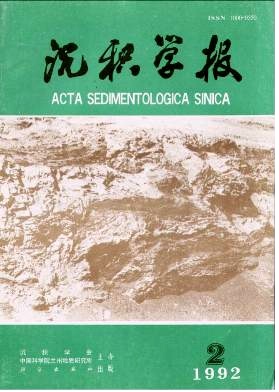Cenozoic Sedimentary Environment in East China Sea Basin
- Received Date: 1990-04-30
- Publish Date: 1992-06-10
Abstract: East China Sea Basin is a large Cenozoic sedimentary basin developed in the eastern continental shelf area of China, with 250000km of the area and over 12000 m of maximum thickness. Four depositional se quences have been interpreted in the basin, based on the study and analysis of seismic stratigraphy, drilling lilhological and paleontologic data and so on. These sequences are sequence Ⅰ late Cretaceous-Paleocene with the largest thickness of 85000m, distributed only in the west of the basin, sequence Ⅱ Eocene with maximum thickness of 6000 m in the east and about 1000m in the west, sequence ⅢOligocene-Miocene with up to 5000m of largest thickness, and sequence Ⅳ Pliocene-Quaternary with sedimentary thickness of approximately 2000m. The boundaries between these sequences are all angle unconformity. These sequences are characterijed by different evolution, lithology, paleontology and depositional environment. Sedimentary environments were analysed: Neritic fades and alternative marine and terrestrial facies appeared in the west of the basin with sea transgression from southeast in late Cretaceous-Paleocene. In Eosene neritic facies developed predominantly in the southwest of the basin, and in the east of Oligocene fluviolacustrine facies appeared and developed only in the basin alternative estuary and lake fades occured. the east, and in Miocene fluviolacustrine facies developed dominantly with swamp subfacis. in the both south and north extremities some local areas were affected by sea water. From Pliocene to Quaternary sedimentary environment changed gradually from fluvial to littoral and neritic facies. The article indicates various assemblages of source rocks, reserviors and sealing rocks formed by different sedimentary enviton ments. Main source rocks are Paleoeene in the west of the basin and Eocene in the east of it, and late Cretaceous is possible significant source rock and Oligocene and lower Miocene is favorable source rocks in the east.. Even though only a few wells have been drilled in the basin potential prospects have been show already. It is believed with our confidence that there are geological conditions to form large oil and gas field m East China Sea Basin
| Citation: | Wang Guochun, Zhu Weilin. Cenozoic Sedimentary Environment in East China Sea Basin[J]. Acta Sedimentologica Sinica, 1992, 10(2): 100-108. |






 DownLoad:
DownLoad: